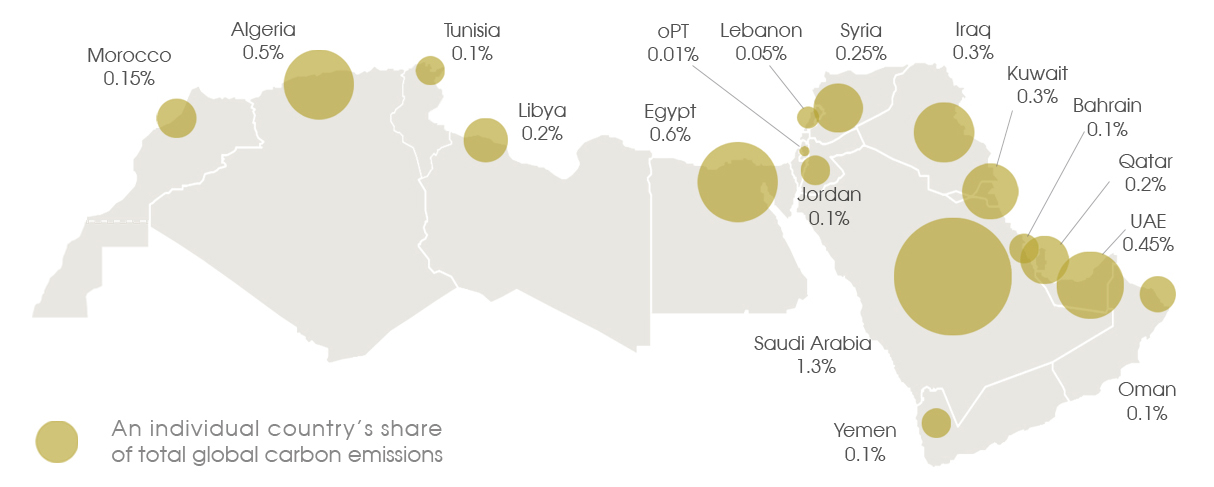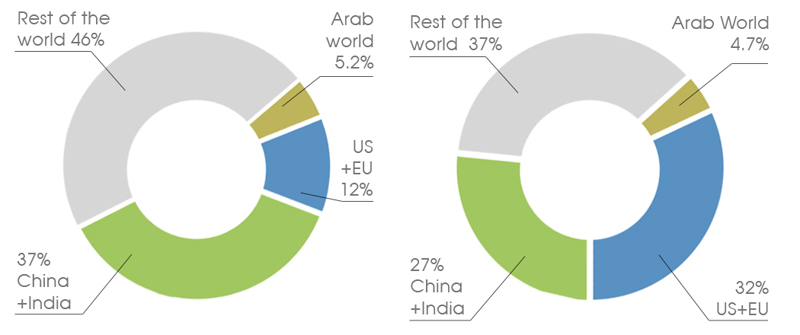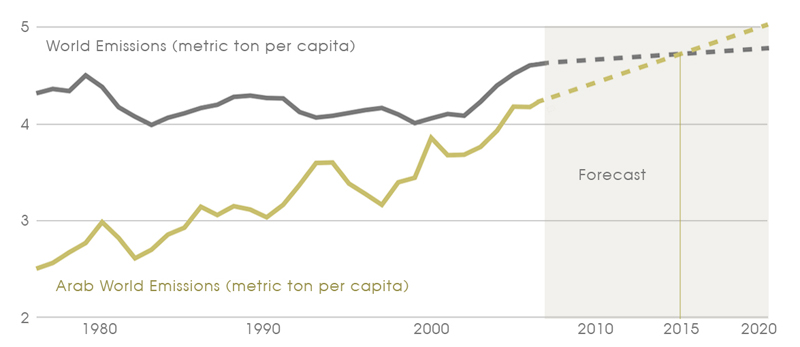Karim Elgendy
Discussions on the environment in the Arab World have traditionally been limited to the negative impact of region’s fossil fuel exports on climate change. In recents years, a more regional discourse has emerged that also addressed the region’s water scarcity, rapid urbanization, environmental degradation, and the expected impact of global climate change and sea level rise on its most vulnerable regions.

Map showing emissions in countries of the arab world as percentage of global emissions. Copyrights: Carboun
However, such discussions often overlooked the region’s own energy and ecological footprints and the impact of its own energy use on climate change. In the past , such disregard may have been justified by the fact that the region had not yet experienced the kind of economic development and prevalent consumerism that was common in most of the developed world. Such justification was supported by the region’s historically low rate of energy use and carbon emissions. In fact, the Arab world which constitutes 5% of the world’s population, emits just under 5% of global carbon emissions according to World Bank data, and except for Saudi Arabia, no single Arab country is responsible for more than 1% of global emissions. The energy use of an average Arab person is still below the world average and less than half that of an average european.

Share of global emissions of selected regions and countries (left) and share of global population of the same regions and countries (right). Copyrights: Carboun
But the modesty of these figures should not mask the more complex picture of energy and emissions in the region, which reflects underlying, and more alarming, trends.
Rapidly growing consumption
While global carbon emissions per capita have only marginally increased over the last 30 years, emissions of the average Arab person have almost doubled. At current rates, it is expected that the emissions of an average Arab person will exceed the global average in the next 5 years, with no sign of a slowing down.
Such rapid growth in emissions is compounded by the fact that the energy use responsible for the region’s emissions is not particularly efficient. In fact, with the exception of subsaharan Africa, the Arab World’s economy has the lowest energy efficiency record of any region in the world. The region generates a mere $4.6 of GDP per unit of energy consumed (kg of oil equivalent), which compares poorly against energy efficient economies such as those of European Union, which creates $8.1, and Latin America, which creates $7.5. The region even compares unfavorably to the energy inefficient North American economies which generate $5.6 per unit of energy consumed.

Historical record and forecast of changes in per capita carbon emissions in the Arab world compared to the world per capita average. Copyrights: Carboun
Two Energy and Emissions trends
But an investigation of intra-regional variation in energy use and emissions suggests that the use of the term ‘average Arab person’ may not be the most pertinent in describing the region’s environmental condition. Much of the variations in energy use and emissions in the region appear not to correspond to population sizes but rather to patterns of consumption. Saudi Arabia, for example, represents 7% of the region’s population yet is responsible for 28% of the region’s emissions. Remarkably, Saudi Arabia – with a population of 25 million – produces more carbon emissions than more populous and industrialised countries such as France of (62 million), Brazil (194 million), and Spain (45 million). Egypt on the other hand, which represents 25% of the region’s population is responsible for a mere 13% of the region’s carbon emissions.
To better understand this diverse regional picture it is more appropriate to divide the region’s states into groups representing the dominant energy, emissions, and environmental trends. In such classification two groups emerge: a resource-rich group, representing fossil-fuel exporting countries with rentier economies and high per capita oil and gas exports, and a resource-poor group, with more diverse economies and generally less resources.
The resource-rich group, which includes Qatar, Kuwait, UAE, Bahrain, Saudi Arabia, Oman, and Libya, is characterized with extremely high levels energy use and carbon emissions per capita. In fact, residents of the first four countries in this group are ranked amongst the world’s top five emitters per capita, with Qatar topping the global list at a staggering rate of 12 times the global average. In comparison, emissions from the resource-poor countries, which includes Algeria, Jordan, Syria, Iraq, Lebanon, Tunis, Egypt, Morocco, Yemen, and the palestinian territories, tend to have much lower levels and never exceed the global average.
Part of the reason behind such a high rate of energy use and emissions in resource-rich countries is water scarcity. Countries that belong to this group share a general lack of sufficient renewable water resources within their borders, and have to depend on other non-renewable water sources in order to satisfy the needs of growing populations. In most cases, especially in Saudi Arabia and the United Arab Emirate, these countries adopted desalination of sea water as a solution to their water challenges. But given the energy-intensive nature of the desalination process, and given that these countries rely on fossil fuels as an energy source for operating desalination plants, this has only added to their energy demand and subsequently their carbon emissions. It is estimated that the emirate of Abu Dhabi uses more than half of its domestic energy use in desalination.
Subsidies as a driver for excessive consumption
In resource-rich countries, energy use is so high that it makes for an exceptionally low economic energy efficiency. Producing an average of $3.7 of GDP per unit of energy consumed, economies that belong to the resource-rich group have a low energy efficiency even when compared to the resource-poor states. As a matter of fact, the economic energy efficiency of resource-rich countries is only marginally higher than that of of sub-Saharan Africa which produces $3.3 of GDP per unit of energy. This low efficiency and increased energy use and carbon emissions cannot be explained by water desalination alone. Instead it can also be attributed to the heavy subsidies on energy prices which are common in their economies. On average, the cost of petrol in resource-rich countries is a fifth of global prices, compared to three quarters in the case of the resource-poor group. Similarly, the average cost of electricity in the resource-rich group is a mere sixth of electricity prices in the US, according to study by the Arab Union of Producers. This compares to electricity prices in resource-poor countries that are half of US prices.
Introduced as a social welfare mechanism, these energy subsidies now act as a catalyst for increased consumption, disconnecting consumers from the cost and impact of their growing consumption. It can also be argued that subsidies on petrol have encouraged a reliance on the use of private vehicles and prevented the development of viable public transportation networks, while subsidies on electricity have dis-incentivized energy efficiency measures and encouraged wasteful energy use.
In addition, subsidies on water in most of the resource-rich group have also led to increased water use in its countries. This has lead to additional demands for sea water desalination, which in turn led to an increased demand for energy. In Saudi Arabia, for example, is estimated that a third of oil production is used to satisfy domestic energy needs. This ratio has grown from 3% in 1970 and is expected to rise to 50% over the next 20 years. Such diversion of resources away form revenue-generating exports suggest that growing domestic consumption in resource-rich countries is not only bad for the environment, but it also presents a real danger to its economic development.
Impact on renewables
Furthermore, the price distortions created by these subsidies have made it harder for capital-intensive renewable energy projects to compete in these economies. In fact, renewable energy plans by resource-rich countries with low energy prices tend to be quite modest. Their average declared target for renewables by 2020 hovers over 3% of total energy generation. In comparison, resource-poor countries seem to have higher aspirations, with the their plan targets for 2020 renewables averaging at around 16% of generation.
These energy use and emissions trends should ring alarm bells for the Middle East and especially its resource-rich nations, not least because they do not track an economic development curve. Instead, they appear to be fueled by inappropriate policy choices and uncontrolled consumption As the region remains in flux amidst the greatest reshaping it has seen in decades, it is hoped that when the dust settles that such policies are remedied for a more sustainable future for the region and the world.
For Carboun’s visual guide to energy and carbon emissions in the Arab World, please see Carboun’s latest infographic.
Karim Elgendy is an architect and a sustainable design consultant based in London. He can be contacted at: Karim [at] Carboun [dot] com
To discuss this article, please join Carboun’s vibrant discussion group on Linkedin. For news and updates on sustainability from around the region, join Carboun’s Facebook page or follow its Twitter feed.
